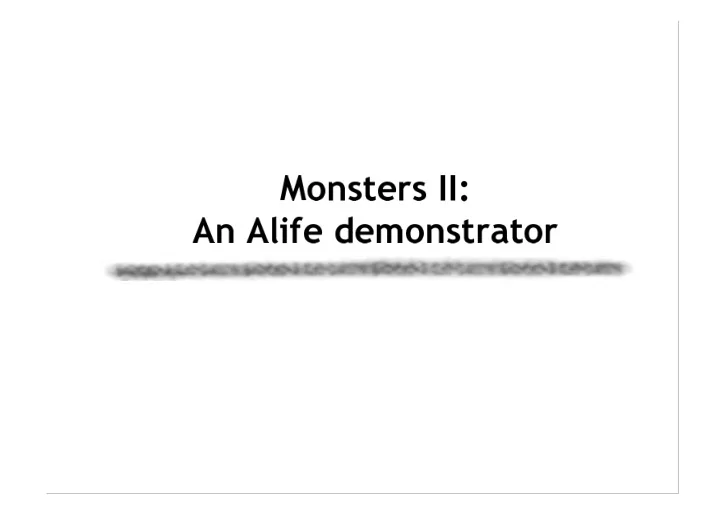

Monsters II: An Alife demonstrator
Monsters II : An Alife demonstrator � Jinigrid � Monsters II � Monsters I � Rendering the world � The virtual world � Programming problems � Questions
Jinigrid � Aim was to provide a grid based in Java using Jini to co-ordinate services and clients. � To make Jinigrid distributable. � Problems � Makefiles � Jar libraries � classpaths vs.. codebases � Solution?
Monsters II � Herbivore World… � A virtual world populated by autonomous creatures. � Creatures interact with each other and their environment. � They breed, and pass on genetic material which codes for behavior and appearance. � Monsters I ...
Creating Monsters II � Create a rendering engine. � Must be flexible enough to accommodate different styles of worlds. � Design a world biology from the bottom up. � Agree on basic nutritional elements synthesized and provided by the plants. � Design a virtual machine to inhabit the world. � Programmable state machine. � Sufficiently complex to be interesting and unpredictable
The World � The world is based upon a grid of squares. � Grid must be Z x ( n x Z) for ease of fractal generation � Each square has certain attributes: � Height(actually has x4 heights and x4 normals) � Temperature at the moment � Humidity at the moment � A flag which contains data about what is located on it. � The meaning of two other data items depends on what this first flag contains.
Rendering the world � Rendering engine uses DirectX 7.0 � First we need to find out what is the minimum data we need to draw. This is dependant on the ‘view frustrum’ … � To find the minimum area project the view frustrum down onto the x-z plane. … � Sort an array of indexes to the renderable data based upon the squares textures. This prevents texture ‘thrashing’. � Render front-to-back when possible(Z-buffer). � Render translucent materials last.
Depth perception � Human eye only uses its ability to change focus for depth perception of nearby objects. � Far objects use visual cues: � Light absorbtion � Depth fogging (also hides ‘popping’). � Parallax � Doom ‘bobbing’. � Known heights
The virtual world: the terrain � The terrain is textured with either a base ‘grass’ texture, or a ‘subwater’ texture. It may be overlaid with a secondary texture if it has a ‘plant’ on it. � Its textures are modulated by a base colour … � Its base colour is dependant on its temperature, � which is a function of its distance from the equator, � its height, � and any effects due to its plant occupant. � This should create arctic and desert regions in the world, to which the inhabitants (plant and creature) can adapt.
The virtual world : the plants � A plant occupies one whole square. It has a species and an age, but is otherwise not individual. There is no instances of ‘plants’. � Some plants are renderable as 3D objects, others merely provide a texture to use on that square. � Plants do not die naturally, only by exposure or being eaten. � Plants created offline using meta language. ... � Plants reproduce by seeding nearby squares depending on environmental factors: � Proximity to fellow species (Conway) � Ambient temperature and humidity � Proximity to a resource (water/rock)
The virtual world: the Monsters � This is the hard part… � …and is still very vague.
The virtual world: the Monsters � Each Monster is an individual instance. � A Monster has DNA which codes for every part of its behaviour and appearance. � Appearance: � Its appearance is based upon its genetic mutation of a basic Monster. � Each has a small individual texture, each distinct but a variation on its species. � Its appearance is also matched in its parameters, so large Monsters will weigh more and use more energy in movement.
The virtual world: the Monsters � Reproduction � Monsters cannot reproduce cross species. � Monsters reproduce by fertilisation of ‘eggs’. � Monsters have genders. � Senses � They can see, hear and smell their surroundings. � Pyramid of needs � Food, water, sleep, reproduction, recreation, discovery. � Adaptive behaviour (learning). � This requires them to have ‘memory’.
The virtual world: the Monsters � Have the concept of a general set of abilities such as ‘interact with’. These can be applied to anything in the world. It returns some value or changes a state. The Monster must be able to judge whether it prefers that state, and ranks that action as better or worse then it ranked it before. � This is a nice idea but may take many generations before a single working Monster evolves. � The environment must be diverse enough to allow ‘niche’ specialisation. Complexity is the key to non determinism and variation.
The world so far � Early world … � World 1 … � World 2 … � Bug corrected world ...
Problems... � Fullscreen debugging. � Time parameterisation. � Aesthetical programming.
Any questions?
Visible area
View Frustrum
DirectX ‘modulate’ � Call � IDirect3DDevice->(0, D3DTSSCOLOROP, D3DTOP_MODULATE); � Tells DirectX to blend texture pixels with underlying material pixels using the formula � Final RGBA = Texture RGBA X Material RGBA � Also has MODULATE2X, MODULATE4X, ADD, ADDSIGNED, ADDSIGNED2X, SUBTRACT, � ADDSMOOTH, D3DTOP_BLENDDIFFUSEALPHA, D3DTOP_BLENDTEXTUREALPHA, D3DTOP_BLENDFACTORALPHA, D3DTOP_BLENDCURRENTALPHA, BLENDTEXTUREALPHAPM , MODULATECOLOR_ADDALPHA, MODULATEINVALPHA_ADDCOLOR, MODULATEINVCOLOR_ADDALPHA, BUMPENVMAP, BUMPENVMAPLUMINANCE and DOTPRODUCT3.
Programming plants � The plants are created beforehand using a plant generator application. It allows the user to set the plants parameters and reactions to a variety of factors . � At run time each plant species (identified by a unique ID) is passed, via the plant manager singleton, its squares parameters. The plant species returns a texture ID based on its programmed ‘state’ during the render call. � During the Update call it takes some action (dies, grows, reproduces) based on its codes and the terrain parameters.
Recommend
More recommend